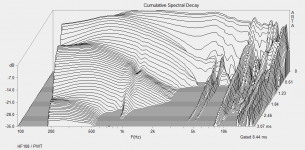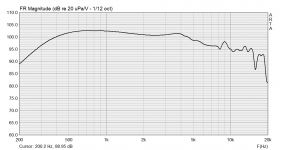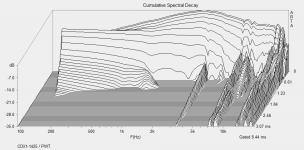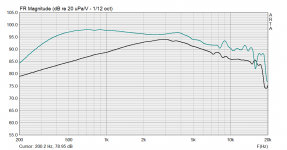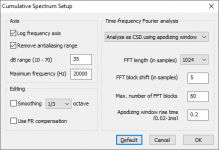I don't think those two graphs made it easier to see, as they point at differing frequencies?
Yes, because the drivers are different in terms of weight etc.
So you think the waveguide resonances, if any, would be excited by the vibrations of the driver? I thought it would be more likely by the sound waves radiated into the waveguide... (?).
Or do you mean that a different mass can change the resonant frequencies of the combo?
Or do you mean that a different mass can change the resonant frequencies of the combo?
Last edited:
I have been working on a little python script to step through a number of simulations.
Here I have 16 sims where Length and Term.N have been stepped through 4 numbers each.
It took around 20 mins to complete
View attachment 919119
The code is far from optimized, but it didn't crash, so that's something 😛
A Great time saver! any chance you could share the code?
So you think the waveguide resonances, if any, would be excited by the vibrations of the driver? I thought it would be more likely by the sound waves radiated into the waveguide... (?).
No, I'm not sure, but as Dr. Geddes suggested, they may very well be related to the waveguide (material/wall thickness/etc.).
It's just not obvious to me why and how should the mass of the driver enter into the picture, that's my question.
It's complicated matter, but it's (probably) related to the driver-to-horn mass ratio and the "coefficient of restitution".
Ok, now it seems safe to conclude that the ringing of the horn is negligible.
Perhaps you can also "hang the Celestion on the pipe", just to be sure.
Perhaps you can also "hang the Celestion on the pipe", just to be sure.
It's just not obvious to me why and how should the mass of the driver enter into the picture, that's my question.
Changing driver mass would change the system resonances, because that mass is coupled to the waveguide and subject to the forces produced by the driver itself.
If you really want to do some math, you could model it with a lumped elements model. I believe you could use a forced two-mass spring and damper system, but I'll admit it's been a while since I've had to solve differential equations like that.

https://web.itu.edu.tr/~gundes/2dof.pdf
So you think the waveguide resonances, if any, would be excited by the vibrations of the driver? I thought it would be more likely by the sound waves radiated into the waveguide... (?).
Or do you mean that a different mass can change the resonant frequencies of the combo?
I don't know if they are waveguide resonances, but a different mass will certainly change the resonance frequencies. I am looking at around 5 and 9 kHz.
Unless your PWT rings more than the waveguide, I'd say those resonances are primarily driver-related.
Last edited:
Could perhaps someone with a 3D printed waveguide show their decay plot (CSD)? This is the settings I used in ARTA (96 kHz sampling). ARTA is free as an extremely usable demo.
Or anyone else for that matter. The more data the better.
Or anyone else for that matter. The more data the better.
Attachments
Last edited:
python code
@tmuikku
I have attached the code in a .zip file. There are three files; the main sequencer, a functions file and data container file.
If you look at this code form the sequencer there are two arrays called modLength and modN where the values are put into. Two nested for-loops run through the code. The code is not very dynamic as it is. If you want to run through more/other variables, another layer of for-loop must be added.
In order to interface with ABEC I use a library that can execute keyboard commands on programs in the foreground, so when the code is running just step back from the computer 😀 otherwise it might cause unexpected behaviour.
Luckily the keyboard presses are quite benign just a little F5 & F7 and so on.
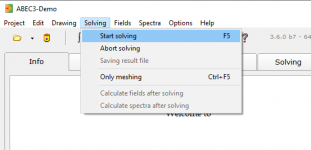
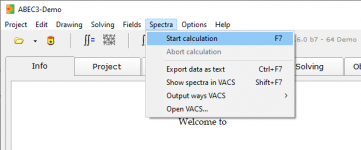
@tmuikku
I have attached the code in a .zip file. There are three files; the main sequencer, a functions file and data container file.
If you look at this code form the sequencer there are two arrays called modLength and modN where the values are put into. Two nested for-loops run through the code. The code is not very dynamic as it is. If you want to run through more/other variables, another layer of for-loop must be added.
Code:
snippet from main file...
athRoot = "C:\\ath-4.7" #Define root path where ath.exe is located
varWorker = athABEC_simParameters.varOutput() #Create class for variables
strWorker = athABEC_simParameters.stringOutput() #Create class for strings
[B]modLength[/B] = ['100','200']
[B]modN[/B] = ['1','2']
start = time.time()
for i in [B]modLength[/B]:
for j in [B]modN[/B]:
loopFid = 'C:\\ath-4.7\input\outputTest_L' + i + '_N' + j + '.cfg' #Define output file
varWorker.[B]Length[/B] = [i] #Set new parameter
varWorker.[B]Term_n[/B] = [j]
functions.generateScriptContent(loopFid,varWorker,strWorker) #Generate content for file for ABEC
functions.executeABEC(loopFid,athRoot) #Execute generated file with ABEC through ath.exe
...In order to interface with ABEC I use a library that can execute keyboard commands on programs in the foreground, so when the code is running just step back from the computer 😀 otherwise it might cause unexpected behaviour.
Code:
code snippet from the functions file ...
time.sleep(5)
keyboard.press(Key.f5)
time.sleep(0.1)
keyboard.release(Key.f5)
time.sleep(1)Luckily the keyboard presses are quite benign just a little F5 & F7 and so on.


Attachments
This is my printed horn with DE500: DE500-260mmATH.mdat - Google Drive
And this is the same horn with Beyma CP385/Nd: CP385Nd260mmATH.mdat - Google Drive
These are REW projects, maybe it can be somehow exported and imported to ARTA?
And this is the same horn with Beyma CP385/Nd: CP385Nd260mmATH.mdat - Google Drive
These are REW projects, maybe it can be somehow exported and imported to ARTA?
ARTA can import WAV file as an impulse response. Or maybe REW has something similar (as CSD), I don't know. But it would be great to see those.
It seems there's no data in the files, just silence.
Edit: No, it's there, very low level. I will try to get something out of it.
Edit: No, it's there, very low level. I will try to get something out of it.
Last edited:
- Home
- Loudspeakers
- Multi-Way
- Acoustic Horn Design – The Easy Way (Ath4)
